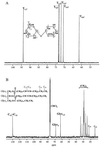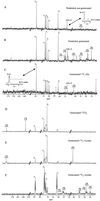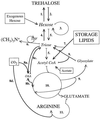Carbon metabolism in spores of the arbuscular mycorrhizal fungus Glomus intraradices as revealed by nuclear magnetic resonance spectroscopy
- PMID: 10482682
- PMCID: PMC59376
- DOI: 10.1104/pp.121.1.263
Carbon metabolism in spores of the arbuscular mycorrhizal fungus Glomus intraradices as revealed by nuclear magnetic resonance spectroscopy
Abstract
Arbuscular mycorrhizal (AM) fungi are obligate symbionts that colonize the roots of over 80% of plants in all terrestrial environments. Understanding why AM fungi do not complete their life cycle under free-living conditions has significant implications for the management of one of the world's most important symbioses. We used (13)C-labeled substrates and nuclear magnetic resonance spectroscopy to study carbon fluxes during spore germination and the metabolic pathways by which these fluxes occur in the AM fungus Glomus intraradices. Our results indicate that during asymbiotic growth: (a) sugars are made from stored lipids; (b) trehalose (but not lipid) is synthesized as well as degraded; (c) glucose and fructose, but not mannitol, can be taken up and utilized; (d) dark fixation of CO(2) is substantial; and (e) arginine and other amino acids are synthesized. The labeling patterns are consistent with significant carbon fluxes through gluconeogenesis, the glyoxylate cycle, the tricarboxylic acid cycle, glycolysis, non-photosynthetic one-carbon metabolism, the pentose phosphate pathway, and most or all of the urea cycle. We also report the presence of an unidentified betaine-like compound. Carbon metabolism during asymbiotic growth has features in between those presented by intraradical and extraradical hyphae in the symbiotic state.
Figures




References
-
- Amijee F, Stribley DP (1987) Soluble carbohydrates of vesicular-arbuscular mycorrhizal fungi. Mycologist 21–22
-
- Azcón-Aguilar C, Bago B (1994) Physiological characteristics of the host plant promoting an undisturbed functioning of the mycorrhizal symbiosis. In S Gianinazzi, H Schüepp, eds, Impact of Arbuscular Mycorrhizas on Sustainable Agriculture and Natural Ecosystems. Birkhäuser Verlag, Basel, pp 47–60
-
- Azcón-Aguilar C, Bago B, Barea JM. Saprophitic growth of AMF. In: Varma A, Hock B, editors. Mycorrhiza: Structure, Function, Molecular Biology and Biotechnology, Ed 2. Berlin: Springer-Verlag; 1998. pp. 391–408.
-
- Bago B, Azcón-Aguilar C, Goulet A, Piché Y. Branched absorbing structures (BAS): a feature of the extraradical mycelium of symbiotic arbuscular mycorrhizal fungi. New Phytol. 1998;139:375–388.
-
- Bécard G, Doner LW, Rolin DB, Douds DD, Pfeffer PE. Identification and quantification of trehalose in vesicular-arbuscular mycorrhizal fungi by in vivo13C NMR and HPLC analyses. New Phytol. 1991;118:547–552.
Publication types
MeSH terms
Substances
Grants and funding
LinkOut - more resources
Full Text Sources
Medical

